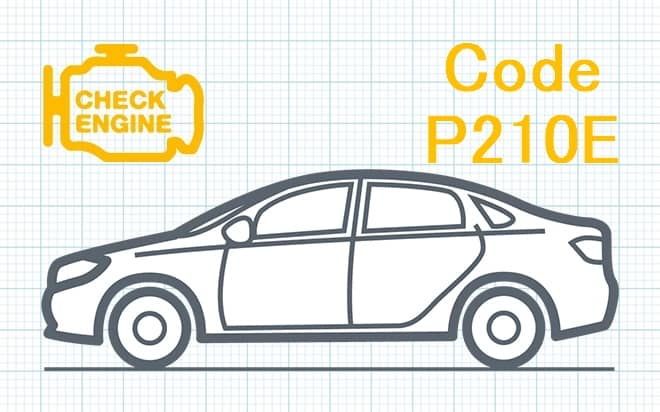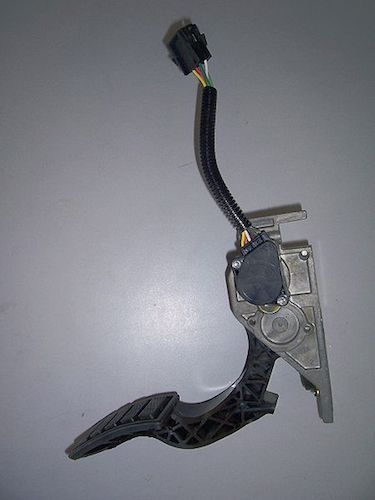
P210E Throttle / Pedal Position Sensor C / F Voltage Correlation
Content
P210E Throttle / Pedal Position Sensor C / F Voltage Correlation
OBD-II DTC Datasheet
Throttle / Pedal Position Sensor / C / F Switch Voltage Correlation
What does this mean?
This Diagnostic Trouble Code (DTC) is a generic transmission code. It is considered universal as it applies to all makes and models of vehicles (1996 and newer), although the specific repair steps may differ slightly depending on the model.
Car malfunction code P210E Throttle / Pedal Position Sensor / C / F Switch Voltage Correlation refers to a problem with the throttle valve's ability to open and close properly.
In the 1990s, car manufacturers began to introduce "Drive by wire" throttle control technology everywhere. Its mission is to provide greater control over emissions, fuel economy, traction and stability control, cruise control and transmission response.
Prior to this, the car's throttle valve was controlled by a simple cable with a direct connection between the gas pedal and the throttle valve. The Throttle Position Sensor (TPS) is located opposite the throttle rod connection on the throttle body. The TPS converts the movement and position of the throttle valve into a voltage signal and sends it to the engine control computer, which uses the AC voltage signal to form the engine control strategy.
The new "electronic throttle control" technology consists of an accelerator pedal position sensor, an electronically controlled throttle body complete with an internal engine, two integrated throttle position sensors for correlation coefficients and an engine management computer.
Although the code has the same frame of reference, it is worded slightly differently on some brands, such as “Throttle Position Sensor Circuit Range / Performance” on Infiniti or “Electronic Throttle Control Failure Power Management” on Hyundai.
When you press the accelerator pedal, you press the sensor indicating the desired throttle opening value, which is sent to the engine control computer. In response, the computer sends a voltage to the motor to open the throttle. Two throttle position sensors built into the throttle body convert the throttle opening value into a voltage signal to the computer.
Throttle Body Photo, Throttle Position Sensor (TPS) - black part bottom right: 
The computer monitors the ratio of both voltages. When both voltages match, the system works normally. When they deviate by two seconds, code P210E is set, indicating a malfunction somewhere in the system. Additional fault codes may be attached to this code to further identify the problem. The bottom line is that losing control of the throttle can be dangerous.
Here is a photo of the accelerator pedal with the sensor and wiring attached:
 Photo used by permission of Panoha (Own work) [GFDL, CC-BY-SA-3.0 or FAL], via Wikimedia Commons
Photo used by permission of Panoha (Own work) [GFDL, CC-BY-SA-3.0 or FAL], via Wikimedia Commons
NOTE. This P210E DTC is basically the same as P2135, P2136, P2137, P2138, P2139 and P2140, the diagnostic steps will be the same for all codes.
symptoms
Symptoms of a P210E code can range from stalling to a stop, no power at all, no acceleration, sudden loss of power at cruising speeds, or stuck throttle at current rpm. In addition, the check engine light will illuminate and a code will be set.
Possible Causes of DTC P210E
- In my experience, the wiring connector or pig tail on the throttle body gives problems in the form of a bad connection. The female terminals on the pigtail are corroded or pulled out of the connector.
- Possible short circuit of bare wire to pigtail to ground.
- The top cover of the throttle body is deformed, which interferes with the correct rotation of the gears.
- Electronic throttle body defective.
- Defective accelerator pedal sensor or wiring.
- The engine control computer is out of order.
- The TPS sensors have not correlated for a few seconds and the computer needs to cycle through a re-learning phase to regain active throttle body response, or the computer needs to be reprogrammed by the dealer.
Diagnostic / repair steps
A few notes about the electronically controlled throttle. This system is incredibly sensitive and more vulnerable to damage than any other system. Handle it and its components with extreme care. One drop or rough treatment and that's history.
In addition to the accelerator pedal sensor, the rest of the components are located in the throttle body. Upon inspection, you will notice a flat plastic cover at the top of the throttle body. It contains the gears for actuating the throttle valve. The motor has a small metal gear protruding from the housing under the cover. It drives a large "plastic" gear attached to the throttle body.
The pin that centers and supports the gear goes into the throttle body, and the top pin goes into the "thin" plastic cover. If the cover deforms in any way, the gear will fail, requiring a complete throttle body replacement.
- The first thing to do is go online and get the TSB (Service Bulletin) for your vehicle associated with the code. These TSBs are the result of customer complaints or identified problems and the manufacturer's recommended repair procedure.
- Check online or in your service manual for a possible re-learning procedure to restart your computer. For example, on Nissan, turn on the ignition and wait 3 seconds. Within the next 5 seconds, press and release the pedal 5 times. Wait 7 seconds, press and hold the pedal for 10 seconds. When the check engine light starts flashing, release the pedal. Wait 10 seconds, press the pedal again for 10 seconds and release. Switch off the ignition.
- Remove the electrical connector from the throttle body. Inspect it carefully for missing or bent output terminals. Look for corrosion. Remove any traces of corrosion with a small pocket screwdriver. Apply a small amount of electrical grease to the terminals and reconnect.
- If the terminal connector is bent or missing pins, you can buy a new pigtail at most auto parts stores or your dealer.
- Inspect the top cover of the throttle body for cracks or deformation. If there are, call the dealer and ask if they only sell the top cover. If not, replace the throttle body.
- Use a voltmeter to check the accelerator pedal sensor. It will have 5 volts for reference, and there will be a changing signal next to it. Turn on the key and slowly depress the pedal. The voltage should gradually increase from 5 to 5.0. Replace it if the voltage rises sharply or there is no voltage on the signal wire.
- Search the Internet for the identification of the wire terminals on your car's throttle body. Check the throttle body connector for power to the throttle motor. Ask the assistant to turn on the key and lightly press the pedal. If there is no power, the computer is faulty. The throttle body is defective when energized.
Other throttle related DTCs: P0068, P0120, P0121, P0122, P0123, P0124, P0510 and others.
Related DTC discussions
- There are currently no related topics in our forums. Post a new topic on the forum now.
Need more help with code p210e?
If you still need help with DTC P210E, post a question in the comments below this article.
NOTE. This information is provided for informational purposes only. It is not intended to be used as a repair recommendation and we are not responsible for any action you take on any vehicle. All information on this site is protected by copyright.
